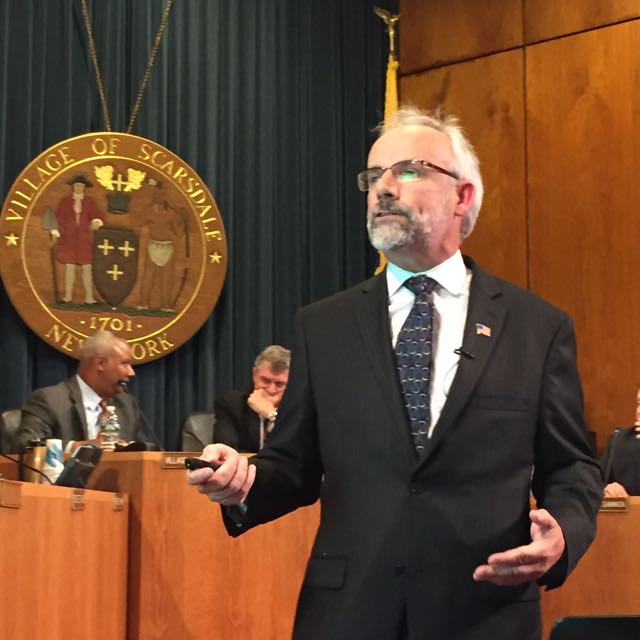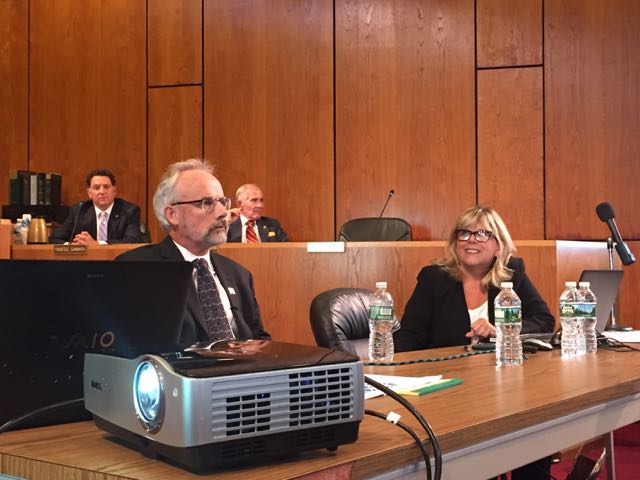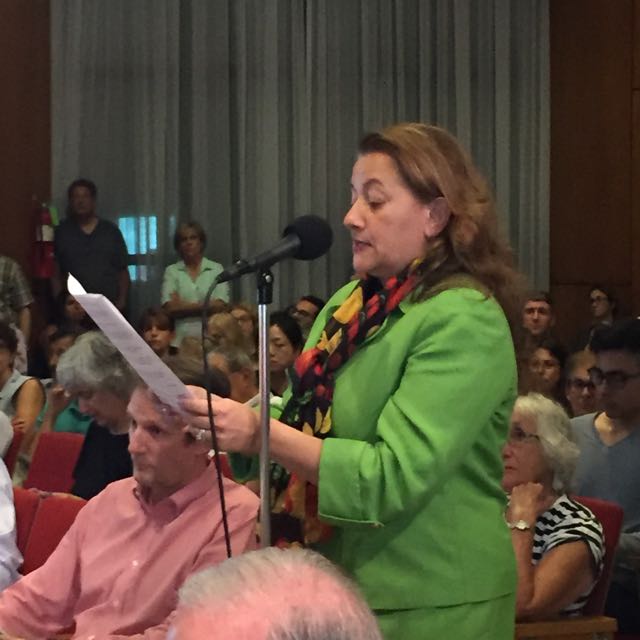J.F. Ryan Attempts and Fails to Explain Valuation Model
- Thursday, 18 August 2016 09:40
- Last Updated: Thursday, 18 August 2016 15:57
- Published: Thursday, 18 August 2016 09:40
- Joanne Wallenstein
- Hits: 16148
 At a packed and heated meeting at Village Hall on August 17th, John F. Ryan, the man who produced the 2016 revaluation, was reprimanded for failing to "show his work," by a frustrated group of residents who sought to understand the derivation of the direct market value he used to significantly alter the assessments of many homes in Scarsdale.
At a packed and heated meeting at Village Hall on August 17th, John F. Ryan, the man who produced the 2016 revaluation, was reprimanded for failing to "show his work," by a frustrated group of residents who sought to understand the derivation of the direct market value he used to significantly alter the assessments of many homes in Scarsdale.
Some feared he would fail to show up, but he appeared as scheduled and sought to answer questions that had previously been sent his way. Despite a smooth presentation about the theory behind the model, he was unable to satisfy an angry group who made a persuasive case that he did a slipshod job on the 2016 revaluation. Ryan showed new data to demonstrate that his model successfully predicts sale prices, but did not reveal the derivation of the coefficients used to build the model. He also claimed that he no longer had any of the reports that were run after the model was formulated and tested, but defended his work contending that his model was a strong predictor of market values. Saying he "attempted to find the best combination of property components to estimate the value" and that he used "appraisal judgment," Ryan implied that he used his expertise, rather than mathematical formulas, to derive the model coefficients. Because the residents were unable to reproduce the output of Ryan's model, they remained highly suspicious of the new valuations and also claimed that the model was significantly biased, causing smaller properties to be over-assessed, and larger ones to be under-assessed
Ryan opened the meeting with a lengthy  presentation of his credentials and history with the Village of Scarsdale. He explained that he was originally retained to do project monitoring services on the 2014 revaluation, including on-site quality and vendor collected data review. At the time, he recommended that implementing the 2014 revaluation would improve fairness.
presentation of his credentials and history with the Village of Scarsdale. He explained that he was originally retained to do project monitoring services on the 2014 revaluation, including on-site quality and vendor collected data review. At the time, he recommended that implementing the 2014 revaluation would improve fairness.
He defended the timing of this second revaluation on the heels of the first one, saying, "New York State recommends cyclical revaluation. It is best management practice to maintain values at market value. There were changes in market conditions since 2013. The assessment required updating to improve fairness (which brought a big boo and hiss from the audience.)" He added that there were concerns in the 2014 revaluation about the 48 sub-neighborhoods created by Tyler. In Ryan's model for 2016 these were condensed into 16 sub-neighborhoods.
Ryan explained that in 2014 Tyler Technologies employed automated comparable sales using seven value indicators (or combinations thereof). He said, that the 2014 revaluation was "an opaque process that is difficult for the appraiser's office to maintain because the assessor can't get into the head of the field reviewer." He explained, "for the 2016 revaluation, it was made clear to us that we needed a more clear, more transparent process for the assessors office and the residents." This statement also brought boos from the vocal crowd, as they bemoaned the lack of transparency in Ryan's approach.
Critics were keen to find out why so many sales had been thrown out of the model, and both Ryan and Albanese sought to explain the wide variety of reasons that over 100 sales were discarded. They said that out of the 499 sales during that period, 395 were considered valid sales and used to build the model, but only 220 were used to validate it. Some of the reasons sales were thrown out were because properties straddled neighborhoods, no money was transferred, buyers and sellers were related, they were not arms length transactions or the properties were knocked down or changed in condition following the sale.
 Though the assessor said that invalidation codes were provided for each sale that was discarded, that data has not been made public. This was also a cause for concern for those who spent many hours trying to understand the model and reproduce the results.
Though the assessor said that invalidation codes were provided for each sale that was discarded, that data has not been made public. This was also a cause for concern for those who spent many hours trying to understand the model and reproduce the results.
Ryan gave a lengthy defense of his qualifications and those of the others who worked on the revaluation. He explained that the original team included Roland Gosselin, who discovered he had a stage four glioblastoma (brain tumor) in January and was not able to work. In his place, they hired Gerd Semmelroggan, an unlicensed residential appraiser, to do the drive bys for the revaluation.
He explained the factors that went into the model, but did not provide the derivation of the coefficients that were used in it. Particularly troubling to the group, were the neighborhood coefficients that assigned a 1.3 to Fox Meadow, thereby boosting valuations for that neighborhood.
In the week prior to the meeting, the Mayor had said that all questions for Ryan should be submitted on index cards to the Village Staff, who would sort through them and pose questions at the meeting. However, there were loud objections to that procedure by some who wanted to verbally question Ryan at the meeting. The Mayor ultimately relented and it quickly became clear why these residents wanted the opportunity to speak. Their questions, and statements veered away from the statistical model to direct attacks on Ryan, his credentials, his staff, the history of other revaluations he conducted and his relationship with Ms. Albanese. In fact, rather than a Q&A, portions of the meeting felt more like a court martial, with residents cross-examining Albanese, Ryan, the Mayor, Trustees and the Village Attorney.
Josh Frankel who has been a vocal opponent of the 2016 reval said, "42% of the sales are invalid. .... These need to be documented. No one knows where the missing sales went. The law says that no more than 10-20% of outliers should be trimmed. I don't see the explanation."
Albanese explained, "There are no missing sales. There was a misunderstanding about the number of sales that were used to test the model. The numbers are accurate." Her voice cracked as she pleaded with Frankel, saying, "Josh --what other possible explanation could there be?" Mayra Kirkendall-Rodriguez who has led the campaign to discredit Ryan and void the revaluation came to the mic to take on Ryan and Albanese. She revealed that Gerd Semmelroggan had been arrested during the time he worked in Scarsdale. Rodriguez sought to make the Village Managers, Albanese and Ryan look irresponsible. She charged, "How could you not know he was arrested? Were you aware that Gerd was driving around after he was arrested?" She implied that he posed a danger to the residents and also worked three less days due to the arrest. Village Attorney Wayne Essanason defended the village, saying, "We can only know he was arrested when we're told! These charges are allegations. There are two sides to every story. It is improper and incorrect for you to imply that the community was threatened. The crime itself is a landlord-tenant dispute. It does not include burglary or dishonesty."
Mayra Kirkendall-Rodriguez who has led the campaign to discredit Ryan and void the revaluation came to the mic to take on Ryan and Albanese. She revealed that Gerd Semmelroggan had been arrested during the time he worked in Scarsdale. Rodriguez sought to make the Village Managers, Albanese and Ryan look irresponsible. She charged, "How could you not know he was arrested? Were you aware that Gerd was driving around after he was arrested?" She implied that he posed a danger to the residents and also worked three less days due to the arrest. Village Attorney Wayne Essanason defended the village, saying, "We can only know he was arrested when we're told! These charges are allegations. There are two sides to every story. It is improper and incorrect for you to imply that the community was threatened. The crime itself is a landlord-tenant dispute. It does not include burglary or dishonesty."
Essanason said a person is presumed innocent until guilty, while Kirkendall-Rodriguez insisted that Semmelroggan must have had a Scarsdale badge with him at the time of his arrest and therefore, the Village should have been advised.
Kai-Hong Teng also sought to demonstrate that Ryan had failed to fulfill his contract. He grilled him on the academic credentials of those he had hired, and brought up several prior assessments conducted by Ryan that were contested. He said, "In 2006 Rockingham Vermont found that your assessments were wrong." In Westport, CT, the reval had to be delayed and postponed." Ryan defended both saying that in Vermont, the department had the wrong timing and in Connecticut there were political issues. Teng then turned to Albanese and said, "Did you interview anyone else for this job?" Inferring that she spent too little time vetting Ryan, he said, "How long do you spend buying a new car?" Referring to FOILED emails, he asked Albanese about a dinner she had with Ryan, and said, "Did you discuss the revaluation? .... Did you receive gifts from Ryan?..... In January 2015 you sent an email to Ryan saying that the second revaluation had passed and that you "were in a tizzy." Why were you excited about this extra workload?" He continued his relentless attack, saying "Why were you spying on residents? At a meeting in June you were in the back of the room ... you remained silent."
Michael Levine, a statistician who has spent many hours analyzing the models used for both revaluations asked Ryan if he ran the reports on Village computers or on his own system. Ryan said they were run on his computer and that he had no reports. Levine responded, "I would think it would be standard practice to save the reports," to which Ryan replied, "The proof is in the pudding." Near the conclusion of the meeting, at around 11:15 pm, Levine returned to the mike to question Ryan further. He said, "What bothers me is you are not disclosing the derivation of every aspect of your model. We expected a soup to nuts explanation of the model. Now you are saying you can't reproduce it. You can't explain where the elements of the model come from and how were they mathematically derived. ... Where is the math beyond the coefficients" (You should have said) "Here is the program, here is the program output. All of that should have been documented."
Jane Curley, another expert in modeling who has recently been appointed to the Board of Assessment Review to rule on grievances also questioned Ryan. She said,
"There is an inconsistency between forcing insignificant variables and saying your model is better than Tyler's. Is this square footage model workable across homes from 1500 to 5000 square feet? Did you do an analysis of contributory value of varying factors?"
Curley said that she used updated sales data to test the model and got a PRD of 1.3, demonstrating that lower value homes are over-assessed. (Note: The relative inequity between appraisals of high-dollar and low-dollar property is measured by the price related differential (PRD)). Ryan repeatedly claimed that using the PRD was not "standard practice," but several of the statisticians who spoke, used this to demonstrate flaws in Ryan's model. She continued, "All the lots on Hamilton are valued at 10% more than Nelson. Is this a "traffic adjustment?" Are the people on Hamilton spending $2,500 too much or too little?"
Several speakers, including Norm Bernstein and Howard Weitz called for the Board of Trustees to invalidate or nullify the 2016 revaluation and revert back to 2014 valuations. They suggested that since Ryan had not fulfilled his contract, the reval could be thrown out. In response, Village Attorney Wayne Essanason read a legal opinion he obtained from the state. He explained that the "Town board has no authority to substitute its judgment for the assessors. You can't say because the contract is bad, the assessment is bad. This board has no authority to substitute their judgment for the assessors." He added that residents can bring their grievances to court for a SCARS proceeding or file an article 7 hearing in Supreme Court.
Other speakers failed to understand New York State law and suggested that Scarsdale use another methodology to value properties. Sparing no words, builder Bobby Ben Simon attacked Ryan, saying, "Hiring you was a major mistake. Your entire business is fraud. You are trying to put the real estate market in a box...The only way you can evaluate the real estate market is by the sales ...There is no other method....you are making all kinds of assumptions and throwing it back on the taxpayer. Scarsdale is unique. There is a reason that a half acre costs different amounts on either side of town. You need to base your model on sales like California and Florida."
Ellen Neidig from Black Birch Lane, said, "This was supposed to be an update to address the outliers. This was just supposed to be a tweak. How is it that such a large number of residences changed? Why was this necessary to completely disassemble Tyler's work? The results were completely outside what we had expected."
As the meeting drew to a close, Ron Parlato of Sherbrooke Road, another developer and homeowner who leads the Heathcote Association, where 40 of some of the most expensive homes in Scarsdale are located, said that in the 2014 reval, these homes were over-assessed. He said, "We showed that the smaller lots got a discount." He said "we brought a lawsuit against the Village of Scarsdale and won." He continued, "The town and the board have been victimized by two revals," which brought a round of applause. It was not clear from him comment whether Parlato personally challenged his own appraisal or brought a lawsuit on behalf of the Heathcote Association, so we checked with the Village and learned that the Heathcote Association as a whole had not challenged the village.
Parlato may have hinted at the real explanation of why this second reval was planned just months after the first one was completed. Vociferous claims from Scarsdale's wealthiest residents, including the Heathcote Association, were cited as justification for the redo. The Heathcote Association presented voluminous data and charts which they claimed demonstrated that those on the high end were bearing too much of the tax burden and supporting those in more modest homes. The only way the Board could address this complaint was to conduct a second revaluation, which the Assessor and Ryan billed as a tweak or fine-tuning. However, because Ryan decided to use a new and untested model, this second revaluation resulted in more than a 10% change in valuation for 49% of Scarsdale's homeowners.
At the end of the meeting, the Mayor indicated that no action would be taken by the Board to nullify or rescind the revaluation, but suggested that this board or a future board might appoint a committee of qualified residents to examine the issues and make recommendations for future revaluations in Scarsdale.
Though it appeared that this meeting might bring the discussion to a close, as I left at 11:40 pm I heard residents in the parking lot organizing a lawsuit against the trustees. If that comes to pass, Scarsdale taxpayers will undoubtedly bear the burden of the defense.
Comments are welcome - but please include your name and address.










